Rob Wolf's Blog, page 15
November 5, 2016
A Crossroads of Contrasts
Times Square has always been a crossroads of contrasts. Its old image–as an epicenter of porn and depravity–contrasts with its newer identity as a showcase for Disney and so-called wholesome (i.e. commercial) family fun in the form of Applebee’s and Ripley’s Believe it or Not. And yet (in another contrast), pockets of porn still linger, side-by-side with packed tour buses and Broadway theaters. There’s also the wealth of the world travelers who clog the sidewalk contrasted with the growing number of homeless who sleep on it. And this video shows a musical contrast in the Times Square subway station: a Michael Jackson wannabee dancing within earshot of an Amish chorus.


October 23, 2016
Risk Assessment Tools are Good (but not without Risk)
A significant trend in criminal justice these days is the adoption of risk-assessment tools. These tools–usually short surveys administered to people who have been arrested or charged with a crime or are being released from incarceration–are used to predict the likelihood of recidivism make decisions about mental health/drug treatment or social services.
In a promising development, social scientists have been seeking to validate the effectiveness of these tools. If a tool is dubbed “validated” or “evidence-based” it means there is empirical research to show that its predictions about the likelihood of recidivism or the appropriateness of a particular social service intervention have a high likelihood of being correct. (I write “high likelihood” because nothing is ever going to be 100 percent predictive).
The application of scientific methods to these tools is exciting; it holds out the promise of being able to remove bias from decisions in the justice system (which, as we know, is rife with bias) and relying on only objective facts to decide punishment. But these tools aren’t foolproof (what is, after all?) One of those dangers is that they can overlook bias so deeply embedded in our culture, they perpetuate it.
That’s one of the points that Professor Reuben J. Miller, assistant professor of social work at the University of Michigan, and his research collaborator Hazelette Crosby-Robinson made when I interviewed them for the Center for Court Innovation’s podcast series New Thinking. They outlined some of the criticisms that have been leveled against risk assessment tools. Those criticisms include placing too much emphasis on geography and criminal history, which can distort the actual risk for clients from neighborhoods that experience an above-average presence of policing and social services. “Geography is often a proxy for race,” Miller says.
You can listen to the podcast, which was recorded on Sept. 30, 2016, on the Center for Court Innovation’s site or iTunes.


October 18, 2016
New York Today
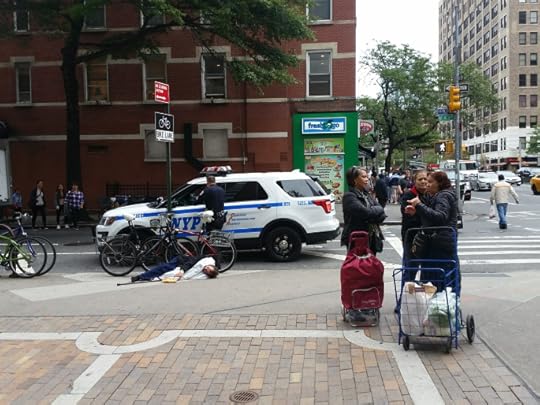
Every day, I see more and more people sprawled on the street. A scene like this is typical: life going on while a guy is flat on the ground. Often, the blankets, boxes and bedding around the figure suggest they are homeless. Less often, the person looks as if they’ve collapsed on the spot–I assume intoxicated with a substance, as appears to be the case with this man whom I saw a couple weeks ago at the corner of 9th Avenue and 43rd Street in Manhattan.
What’s unusual in this photo is that a police officer is on the scene, although the situation doesn’t necessarily call for police intervention. A representative from a social service agency would be ideal. I suppose in the old days (whenever they were), a stranger might have offered a helping hand. Did such days really exist? Perhaps in a small town people were (and are) willing to lend a hand, when requests for help come infrequently. But in Manhattan, where there are people begging on every other street corner and bodies and blankets squeezed into doorways and along sidewalks across Midtown, stopping to help does not feel like a viable option. The problem is too large for any one good Samaritan, and even stopping to give a quarter or a sandwich isn’t a solution (although perhaps it is a solution of the moment, for one person’s fleeting need).
Each person I see provokes a series of questions: Who are they? How did they get there? Are they in any way responsible for their current unfortunate situation or are they entirely victims (and why do I feel the need to assign blame anyway)? Aren’t there social services that can help them? Why are there so many street people? Why don’t they rise up and demand change? Why don’t they travel to a friendlier environment where they can sleep on soft ground and not cement? What was their life like 10 years ago? What will it be like 10 years from now?


October 11, 2016
KGB Bar
I’m thrilled to join an illustrious group of writers (like bestselling novelist Jennifer Belle and Tony-Award winner Lanie Robertson) this Sunday evening for a reading at the legendary KGB Bar. I’ll be sharing a bit of my work-in-progress novel. I hope you can drop by for a drink and some literary entertainment!
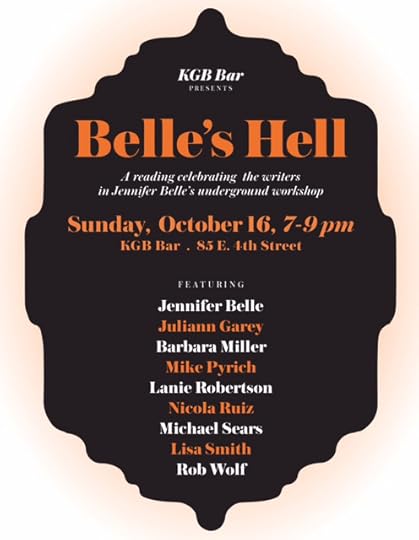


October 10, 2016
An Expert on the Past, Ada Palmer has Little Trouble Inventing a Detailed Future
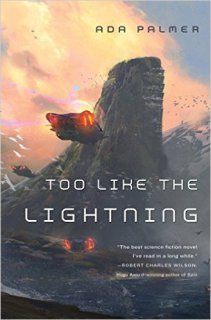
Cory Doctorow has described Ada Palmer’s Too Like the Lightning (Tor, 2016) as a book “more intricate, more plausible, more significant than any debut I can recall.”
That praise reflects Palmer’s immense skill in building a world 500 years in the future but also her vast knowledge of the past. And it’s no surprise that Palmer knows something about the past. In addition to launching the first of a four-volume series with Tor, she is a cultural and intellectual historian at the University of Chicago, where she studies (among other things) the history of publishing and the Italian Renaissance.
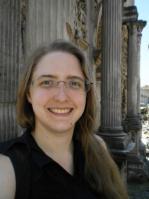
She says that knowing exactly how the world has changed over the last 500 years – politically, culturally, socially – has helped her imagine plausible changes for the next 500.
In Too Like the Lightning, the 25th century is enjoying a reinterpretation of the 18th century Enlightenment, although with flying cars and non-geographic nations. Society congratulates itself for having banished organized religion and gender distinctions (Palmer writes much of the book using the singular “they”) but, as in so many cultures, people are blind to their own shortcomings.
“This is a particular future that didn’t do a good job finishing the end game of feminism and gender equality,” Palmer says, explaining that “they erased it too fast, stopped the conversation and consequently still have tons of baggage.”
Before she put pen to paper, Palmer spent five years planning the world of Too Like the Lightning, including forecasting the future history that shaped it. And it took another eight years for the book to be published.
But critics and readers agree that it was worth the wait. The second installment in the Terra Ignota series, Seven Surrenders, was originally slated for publication in December but Tor has pushed back the release to February to make room for a paperback version of Too Like the Lightning first.
Related link: Voltaire’s Micromegas


August 27, 2016
500 Years in the Future, Humanity Still Has Hangups about Gender: A Conversation with Ada Palmer
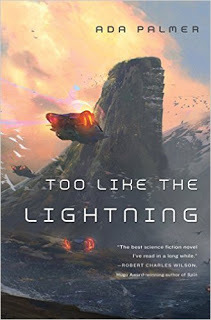
Cory Doctorow has described Ada Palmer's Too Like the Lightning (Tor, 2016) as a book "more intricate, more plausible, more significant than any debut I can recall."
That praise reflects Palmer's immense skill in building a world 500 years in the future but also her vast knowledge of the past. And it's no surprise that Palmer knows something about the past. In addition to launching the first of a four-volume series with Tor, she is a cultural and intellectual historian at the University of Chicago, where she studies (among other things) the history of publishing and the Italian Renaissance.

She says that knowing exactly how the world has changed over the last 500 years - politically, culturally, socially - has helped her imagine plausible changes for the next 500.
In Too Like the Lightning, the 25th century is enjoying a reinterpretation of the 18th century Enlightenment, although with flying cars and non-geographic nations. Society congratulates itself for having banished organized religion and gender distinctions (Palmer writes much of the book using the singular "they") but, as in so many cultures, people are blind to their own shortcomings.
"This is a particular future that didn't do a good job finishing the end game of feminism and gender equality," Palmer says, explaining that "they erased it too fast, stopped the conversation and consequently still have tons of baggage."
Before she put pen to paper, Palmer spent five years planning the world of Too Like the Lightning, including forecasting the future history that shaped it. And it took another eight years for the book to be published.
But critics and readers agree that it was worth the wait. The second installment in the Terra Ignota series, Seven Surrenders , was originally slated for publication in December but Tor has pushed back the release to February to make room for a paperback version of Too Like the Lightning first.
Related link: Voltaire's Micromegas
July 21, 2016
Enlightenment meets traffic jams in Zen City
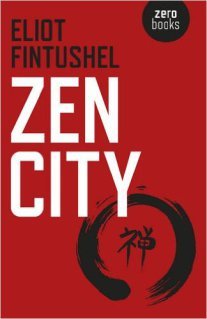
“The future begins with a traffic jam.”
This is how Eliot Fintushel described to me the setting of Zen City (Zero Books, 2016), his science fiction novel about the obstacles encountered along the path to spiritual fulfillment, when I interviewed him on the new episode of New Books in Science Fiction.
 In Fintushel’s book, the quest for enlightenment manifests as a physical journey as his protagonist, Big Man, makes his way from an eternal traffic jam (in which people have been rooted so long on a highway exit ramp that they’ve created cults around their Econoline vans and Chevrolet Chevelles) to the City, where those who have achieved true enlightenment are literally merged into a single body-consciousness that transcends reality as we know it.
In Fintushel’s book, the quest for enlightenment manifests as a physical journey as his protagonist, Big Man, makes his way from an eternal traffic jam (in which people have been rooted so long on a highway exit ramp that they’ve created cults around their Econoline vans and Chevrolet Chevelles) to the City, where those who have achieved true enlightenment are literally merged into a single body-consciousness that transcends reality as we know it.
More than a commentary on Buddhism, the story is a meditation on religion and the challenge of using “robes and rituals” to find enlightenment, Fintushel explains. The problem is when enlightenment itself becomes a sign of status, he says, undermining the goal of enlightenment, which is supposedly a state of “no status.”
Fintushel’s adventure is both poetic and funny, meditating on language as much as belief. He is playing with the “limits of identifying things,” evoking the viewpoint of a baby. “If you watch a baby’s eyes moving around, they don’t fix on objects or even on people the way we do. They don’t have categories of objects and people. And I’m assuming, for the sake of the fiction anyway, that that’s more real than the reality of objects and things and people.”


July 20, 2016
Enlightenment meets traffic jams in Zen City

"The future begins with a traffic jam."
This is how Eliot Fintushel described to me the setting of Zen City (Zero Books, 2016), his science fiction novel about the obstacles encountered along the path to spiritual fulfillment, when I interviewed him on the new episode of New Books in Science Fiction.
 In Fintushel's book, the quest for enlightenment manifests as a physical journey as his protagonist, Big Man, makes his way from an eternal traffic jam (in which people have been rooted so long on a highway exit ramp that they've created cults around their Econoline vans and Chevrolet Chevelles) to the City, where those who have achieved true enlightenment are literally merged into a single body-consciousness that transcends reality as we know it.
In Fintushel's book, the quest for enlightenment manifests as a physical journey as his protagonist, Big Man, makes his way from an eternal traffic jam (in which people have been rooted so long on a highway exit ramp that they've created cults around their Econoline vans and Chevrolet Chevelles) to the City, where those who have achieved true enlightenment are literally merged into a single body-consciousness that transcends reality as we know it.More than a commentary on Buddhism, the story is a meditation on religion and the challenge of using "robes and rituals" to find enlightenment, Fintushel explains. The problem is when enlightenment itself becomes a sign of status, he says, undermining the goal of enlightenment, which is supposedly a state of "no status."
Fintushel's adventure is both poetic and funny, meditating on language as much as belief. He is playing with the "limits of identifying things," evoking the viewpoint of a baby. "If you watch a baby's eyes moving around, they don't fix on objects or even on people the way we do. They don't have categories of objects and people. And I'm assuming, for the sake of the fiction anyway, that that's more real than the reality of objects and things and people."
June 30, 2016
The Brexit Interview: Dave Hutchinson’s Fictional Europe is Falling Apart but Don’t Call Him Prescient

Don’t call my latest guest on New Books in Science Fiction prescient. Even though Dave Hutchinson‘s Fractured Europe Sequence envisions a continent crumbling into ever-smaller countries, the idea that his homeland could Brexit the European Union hadn’t occurred to him when he started writing Europe in Autumn.
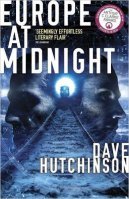 The book chronicles the adventures of Rudi, an Estonian cook-turned-spy who discovers the existence of an alternate Europe, one in which the Eurasian continent has become a Brexiter’s dream come true, a bucolic but boring England that extends from Spain to Siberia.
The book chronicles the adventures of Rudi, an Estonian cook-turned-spy who discovers the existence of an alternate Europe, one in which the Eurasian continent has become a Brexiter’s dream come true, a bucolic but boring England that extends from Spain to Siberia.
Its sequel, Europe at Midnight, isn’t really a sequel but a spinoff, introducing new characters who explore the dark side of Europe’s parallel universes. Both books are imaginative, elegant and unexpected, combining elements of thriller and science fiction. And there’s more to come. A third book, Europe in Winter, is due out in November, and a fourth and final book, Europe at Dawn, is in the works.
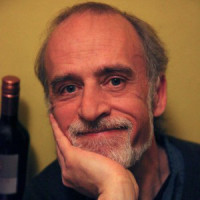 I was fortunate to have Aubrey Fox (author of Trial and Error in Criminal Justice Reform: Learning from Failure) as a co-host for this interview. He not only recommended Hutchinson’s books to me, but he’s an avid fan of both science fiction and mysteries. Among the topics Hutchinson discussed with us were the ideas that inspired him to write Midnight in Autumn, the ups and downs of his long writing career, his decision to write a series when he’d set out to write only a single book, and, of course, the Brexit vote, which took place the day after our conversation.
I was fortunate to have Aubrey Fox (author of Trial and Error in Criminal Justice Reform: Learning from Failure) as a co-host for this interview. He not only recommended Hutchinson’s books to me, but he’s an avid fan of both science fiction and mysteries. Among the topics Hutchinson discussed with us were the ideas that inspired him to write Midnight in Autumn, the ups and downs of his long writing career, his decision to write a series when he’d set out to write only a single book, and, of course, the Brexit vote, which took place the day after our conversation.


June 29, 2016
Dave Hutchinson's Fictional Europe is Falling Apart but Don't Call Him Prescient

Don't call my latest guest on New Books in Science Fiction prescient. Even though Dave Hutchinson's Fractured Europe Sequence envisions a continent crumbling into ever-smaller countries, the idea that his homeland could Brexit the European Union hadn't occurred to him when he started writing Europe in Autumn .
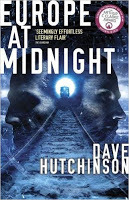 The book chronicles the adventures of Rudi, an Estonian cook-turned-spy who discovers the existence of an alternate Europe, one in which the Eurasian continent has become a Brexiter's dream come true, a bucolic but boring England that extends from Spain to Siberia.
The book chronicles the adventures of Rudi, an Estonian cook-turned-spy who discovers the existence of an alternate Europe, one in which the Eurasian continent has become a Brexiter's dream come true, a bucolic but boring England that extends from Spain to Siberia.Its sequel, Europe at Midnight, isn't really a sequel but a spinoff, introducing new characters who explore the dark side of Europe's parallel universes. Both books are imaginative, elegant and unexpected, combining elements of thriller and science fiction. And there's more to come. A third book, Europe in Winter, is due out in November, and a fourth and final book, Europe at Dawn, is in the works.
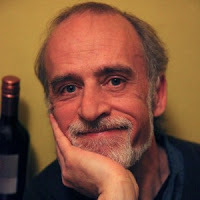 I was fortunate to have Aubrey Fox (author of Trial and Error in Criminal Justice Reform: Learning from Failure) as a co-host for this interview. He not only recommended Hutchinson's books to me, but he's an avid fan of both science fiction and mysteries. Among the topics Hutchinson discussed with us were the ideas that inspired him to write Midnight in Autumn, the ups and downs of his long writing career, his decision to write a series when he'd set out to write only a single book, and, of course, the Brexit vote, which took place the day after our conversation.
I was fortunate to have Aubrey Fox (author of Trial and Error in Criminal Justice Reform: Learning from Failure) as a co-host for this interview. He not only recommended Hutchinson's books to me, but he's an avid fan of both science fiction and mysteries. Among the topics Hutchinson discussed with us were the ideas that inspired him to write Midnight in Autumn, the ups and downs of his long writing career, his decision to write a series when he'd set out to write only a single book, and, of course, the Brexit vote, which took place the day after our conversation.




